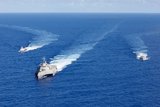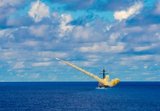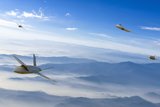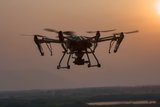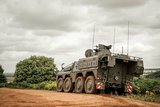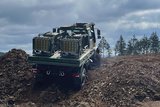Finally! OPVs with Robust Military Grade ISR Capabilities (sponsored)
"Imagination is more important than knowledge. For knowledge is limited, whereas imagination embraces the entire world, stimulating progress, giving birth to evolution."
— Albert Einstein
Offshore Patrol Vessels (OPVs) have become the vessel of choice for monitoring, protecting and showing a presence in the Exclusive Economic Zone (EEZ) that extends 200 miles beyond a country’s coastline. Compact, agile and cost-effective, maritime forces throughout the world continue to demonstrate their preference for OPVs to be used in EEZ in comparison to larger, costlier front-end vessels such as destroyers, frigates and even corvettes. As of the end of 2019, there are over a 1000 OPVs in operation around the world. Examples include Batch II RIVER in the UK, HTMS KRABI in Thailand, and the Israel Shipyards SAAR Class Fast-Attack Vessel family that is active in the Israeli Navy.
These OPVs constitute the backbone of their respective country's offshore operations, guarding against a wide range of threats, including enemy infiltration, terrorism, smuggling, and illegal fishing, mining and immigration. OPVs also play an important role in search and rescue operations and the protection of critical maritime infrastructure such as offshore oil drilling platforms. To carry out these tasks efficiently, OPVs require a complete suite of ISR (Intelligence Surveillance and Reconnaissance) capabilities.
However, until today, the deployment of legacy naval ISR sensors and systems on these vessels has been challenged by their large size, heavy weight and high-power consumption. Moreover, high procurement, operation and maintenance costs have also been prohibitive factors. Recently, governments are being pressured to provide better protection of their borders but are also sensitive to military budget constraints especially with the recent COVID-19 pandemic that is affecting overall government budgets and the accompanying reduction in tax revenue.
OPV commanders often face the challenge of responding to the same threats and executing similar missions to that of larger, more comprehensively equipped vessels but with limited technological tools at their disposal. The demanding mission profiles would be better served by modern, high-performance systems that provide the needed capabilities and performance while at the same time reducing space, weight and cost. Employing these systems not only protects a nation from hostile activities but can also guarantee the safety of the OPV crew.
Military-grade high-resolution radars perform wide range scans of the sea surface out to dozens of kilometers while simultaneously carrying out effective air surveillance. They can detect, track, and classify low RCS (radar cross-section) surface and air threats and discriminate between ships operating in close formation. These sensitive radars are also put to good use in search and rescue operations where their ability to differentiate between surface clutter and actual personnel in distress. Finally, their ability to perform effective air surveillance against drones and UAVs is especially important given the increasing presence of these threats in the littoral arena. In contrast, commercial radars, which focus on short-range navigation, lack these important capabilities. They simply are not designed to perform tracking, classification or air surveillance.
Communication- Electronic Support Measures (C-ESM) enhances the OPV's situational awareness by immediately recognizing the bearing of broadcasting signals while also enabling communications monitoring. Smugglers trying to converse with their co-conspirators onshore will be totally exposed. Radar - Electronic Support Measures (R-ESM) operate at very long ranges and in all-weather conditions to detect a ship’s radar emissions no matter how covertly they are trying to come ashore.
Since its formation over 50 years ago, ELTA Systems, a subsidiary of Israel Aerospace Industries (IAI), has been a world-leading producer of ISR sensors and systems. ELTA offers a wide range of radars, SIGINT, EW, autonomous solutions, communication systems, cyber and intelligence platforms and more to military, security and civilian organizations worldwide, including leading naval forces. Being both a technological leader and innovator, ELTA took their extensive experience and large product portfolio and applied it to the OPV market.
What makes ELTA unique is its ability to innovate and adapt to emerging technologies. With the ever-increasing miniaturization of COTS electronic and computer components, ELTA has created a compact, cost-effective, military-grade ISR Suite that is easily fitted to OPVs without compromising performance. ELTA consolidated its naval 3D AESA radar, reshaped the COMINT antenna, and compressed the ELINT panels to accommodate the limited space aboard OPVs. Flexible installation of the COMINT and ELINT sensors with either a separate mounting scheme or a specially designed unified mast installation ensures optimal performance while saving critical space. Having all the ISR sensors and systems fused into one compact solution, without the need for a dedicated operator, facilitates a coherent Situational Awareness Picture (SAP) with minimal demand on resources.
ELTA’s cost-effective OPV suite is a true force multiplier, delivering the military-grade ISR capabilities of a large vessel at a fraction of the cost.
More from Industry Spotlights
-
![The future is here: Sixth-gen air dominance]()
The future is here: Sixth-gen air dominance
How RTX is equipping the military airspace – for today’s fleet and tomorrow’s fight.
-
![De-Risking the Future: Manufacturing Certainty for Unmanned Systems]()
De-Risking the Future: Manufacturing Certainty for Unmanned Systems
How strategic manufacturing partnership solves the industrialisation triad — Scale, Compliance and Cost — for hyper-growth defence tech innovators.
-
![Battlefield mobility, made in the UK]()
Battlefield mobility, made in the UK
How does Britain ensure that we can preserve the lives of our soldiers and allies – now and in the future – with homegrown innovation and resilient domestic manufacturing? At Pearson Engineering, we are proud to be a central part of the answer to this increasingly important question.
-
![Strengthening Baltic defence capabilities]()
Strengthening Baltic defence capabilities
How Latvia is bolstering its territorial defences, industrial capacity and international cooperation with Dynamit Nobel Defence’s SKORPION2 Remote Mining System.
-
![Barco’s vision to trust: from past to future]()
Barco’s vision to trust: from past to future
Barco’s story is one of constant evolution enabling more immersive, reliable, and future-ready training experiences.
-
![How are next-generation ejection seats helping pilots when they need it most?]()
How are next-generation ejection seats helping pilots when they need it most?
The ACES 5 ejection seat from RTX’s Collins Aerospace introduces new, innovative and patented technologies to help save lives.








